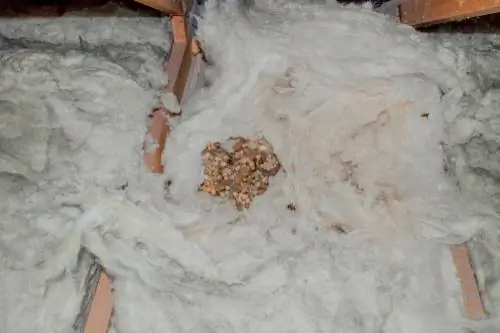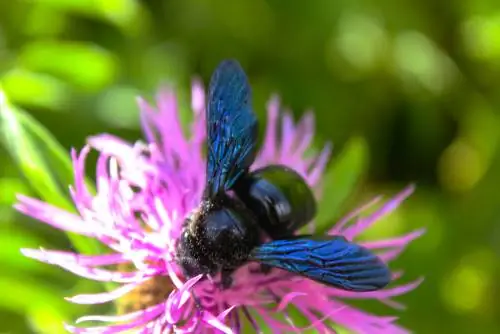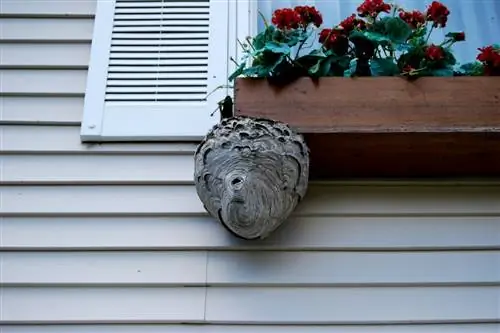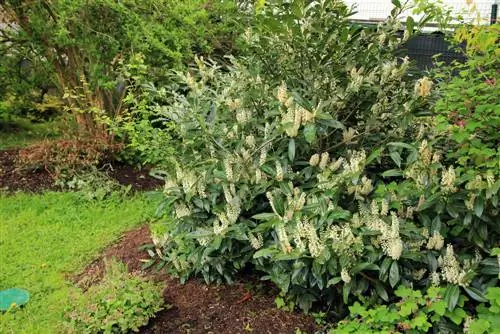- Author admin [email protected].
- Public 2023-12-16 16:46.
- Last modified 2025-01-23 11:22.
Many people are afraid when they discover a nest in the garden or attic. They fear danger to themselves and their children. But if you want to remove the nest, there are a few things you need to consider.
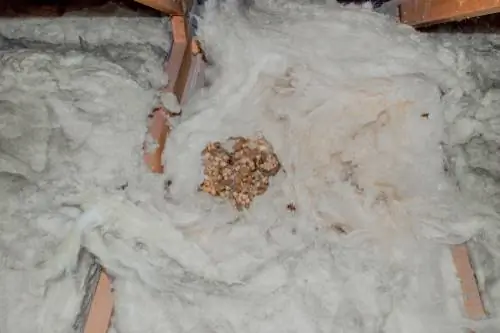
How can I properly have a bee nest removed?
A bee nest should only be removed in exceptional cases; Bees are useful and non-aggressive. Have the nest inspected by a beekeeper or wild bee expert. Removal or relocation is only permitted if people or the bee colony are at risk, as bees are protected.
How to recognize a bee nest
In addition to bees, there are other colony-forming insects that create similar nests. Many of them avoid being near people, even if they settle in gazebos or attics. Most species are harmless and perform useful functions in the garden.
| Nest Cover | habitat | Special feature | |
|---|---|---|---|
| Bees | not available | protected, well-hidden cavities | Honeycomb panels recognizable |
| German wasp | gray | dark, sheltered places | use superficially weathered wood |
| Common wasp | beige | dark, sheltered places | rotten wood from rotting tree trunks |
| hornet | red-brown to orange zoned | rain-protected, dark cavities | Air pockets on the outer shell, with bottom opening |
Where bees settle
In the rarest of cases, a swarm of honey bees looks for a new habitat and settles in private gardens. In this case, the local beekeeper would be happy to receive information about where his bee colony is located. Bee nests in the house usually come from wild bees.
Earth Bees
Around 70 percent of all wild bees build their nests in the ground. They use existing tunnel systems in the ground left by voles or moles. These so-called earth or sand bees can often be observed in the garden. They differ from honey bees not only in their coloring but also in their body size. Earth bees can be between four and 16 millimeters long. They are completely harmless and pose no danger to humans.
mason bees
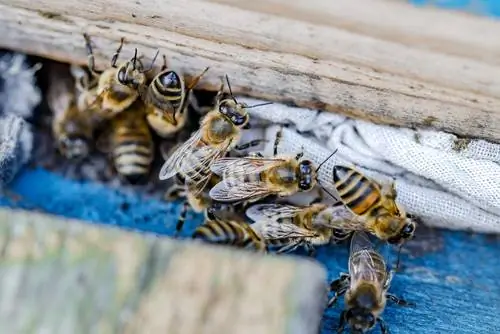
Mason bees often settle in spaces, but are very harmless
These wild bees are often found in the house, under the roof or in the roller shutter box. The harmless cultural followers use various cavities in the roof structure or in flower boxes on the balcony to build their nest. Round and smooth drill holes with a diameter of six to eight millimeters are ideal nesting places.
How to keep mason bees out of your home:
- Prevent nest building and close cavities before settlement
- Put the settled piece of furniture in a shed after the autumn trip
- Offer hardwood blocks as nesting places on balconies and terraces
Nest removal is hopeless
It is only possible to relocate a nest of mason bees with great effort. You would have to wait until the larvae are in their cocoons. The nest closure and partition walls are then carefully scratched open so that the cocoon behind it can be carefully removed with a wire.
Once all the cocoons have been saved, they are placed individually in drill holes and tubes in the new nesting aid. The holes must be closed with a drop of clay. Mason bees are fixated on their nesting sites and are unable to complete a new nest. Since the risk of animals being injured during this action is too great, you should avoid it.
Relocate the bee nest yourself?
Even though there are numerous instructions on how you can relocate a bee nest yourself, you should stay away from such methods. It doesn't matter when the nest should be relocated. The risk of injury to you and the bees is too high, even if it is still a small bee nest.
Legal situation
Bees are among the specially protected species in Germany. The protection status applies to both wild bees that are not cared for by a beekeeper and honey bees. The insects take on important functions in the ecosystem. They ensure that countless flowering plants are pollinated and in this way secure the harvest yield. Anyone who acts against the law risks fines of between 50,000 and 60,000 euros.
It is forbidden:
- Intentionally killing or capturing bees
- Wantically disturbing bee colonies
- Damaging or removing nests
Excursus
Bee death
The term bee death refers, on the one hand, to the losses within the beekeeping culture. In recent decades they have observed significant losses in their bee colonies. But as long as there are beekeepers, honey bees will not die out. The term is also used as a technical term that refers to the death of wild bees. More than 50 percent of German wild bees are on the Red List of endangered species. In the media, the term bee death is often used as a synonym for the general death of insects.
Have the honey bee nest removed
To avoid risking legal pen alties, you should contact a professional. This can assess whether the nest can and needs to be relocated. Points such as existing allergies in the family or proximity to kindergartens play an important role in the analysis.
Bees are beneficial insects that live in peaceful coexistence with humans.
Consult beekeepers
Relocation by a local beekeeper is the best and most cost-effective option. Beekeepers charge an average of 50 euros for relocation. Many beekeepers relocate honey bee nests for free because they can increase their honey production by relocating. If you don't know a beekeeper, you can contact the relevant state beekeeping association or the municipality. NABU can also help you with your search.

Fire department or exterminator only in case of emergency
If there is an acute danger, you can also contact the local fire department. Here you have to expect costs between 100 and 150 euros. Professional exterminators can also remove disturbing nests. Since bees are extremely useful animals, you should carefully consider your decision and refrain from exterminating them by an exterminator.
Tip
Insect sprays are toxic not only to bees and other beneficial insects but also to humans. To keep away, choose ecological alternatives such as scented candles or tea tree oil
Relocate wild bee nest
If wild bees have settled in your garden, you need to consult a wild bee expert. The responsible environmental agency then decides whether the nest can be relocated. In order to get approval, there must be a valid reason. This exists when not only humans but also wild bees are at risk. If the decision is positive, a suitable resettlement procedure will be chosen. This depends on the respective type.
Good reasons for relocation:
- Forest paths must be paved
- Fields and fields need to be fertilized more
- Nest is in a private firewood pile
- Wild bees nest between flower pots or in window seals
Tip
Halve a lemon and crumble a clove on top. Bees hate the smell and naturally stay away from you.
Frequently asked questions
What to do if a bee flies around your apartment in winter?
Young queens look for sheltered places to overwinter in the fall. These can be columns and niches in facades or window frames. If you wake up during the winter due to increased temperatures in the house, your chance of survival is extremely small.
You can still help the bee by holding out a teaspoon of liquid honey. Fill a glass with moist soil and tufts of grass and place the bee in the container. Place the jar in the refrigerator for a few days. The cold-blooded animals reduce their metabolism again.
If you are still in the middle of winter, you should move the bee outside on a frost-free winter day. Place the animal in a rain-protected pile of brushwood or wood where the bee can overwinter until next spring. If spring is approaching, you can leave the insect in the refrigerator until the first warm days of spring and then put it outside.
How do honey bees live?
The insects are among the community-forming animals that build their nests in spring. Some of the old bee colony swarms out to look for a new home. This gives the bees enough time to stock up for the winter. At peak season the colony can number up to 50,000 individuals. It consists of a queen, workers and drones.
What is the bee year?
The bee year is divided into four phases, which are linked to the seasons. In spring the population grows and swarms form that found new states. During the following storage period, the bees collect nectar and pollen. Depending on the region and weather, the beekeeper can harvest up to three harvests.
In late summer there is a so-called drone battle in which all male bees are banned from the hive. After the last honey harvest, the bees are usually fed with a beet sugar solution. The winter bees hatch and overwinter in the hive until spring.
How can I keep bees away?
A peaceful coexistence between humans and bees is not only harmless but also fascinating. So that paths don't cross, you should give the bees an undisturbed area in the garden. Plant a border of wild plants rich in flowers that provide pollen and nectar for insects. Prefer plants with yellow and white flowers. These reflect the ultraviolet light visible to bees. They are also able to detect blue hues.
On the other hand, they cannot distinguish between black and red. These colors make many bees aggressive, which is why you should avoid dark-colored clothing. If you want to keep bees away from the balcony and terrace, you can put up plant pots with basil and lemongrass. The smells have a deterrent effect on bees and wasps.

